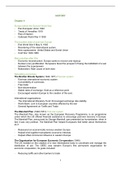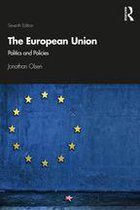HISTORY
Chapter 4
Europe before the Second World War
- Pan-European Union 1922
- Treaty of Versailles 1919
- Rise of Nazism
- Outbreak World War II 1939
The troubled state of post-war Europe
- End World War II May 9, 1945
- Reordering of the international system
- New superpowers: United States and Soviet Union
- Cold War 1940-1980
Main priorities after War
- Economic reconstruction: Europe wants to recover and regroup
- Nuclear (non)-proliferation: Europeans faced the prospect of being the battlefield of a war
between the superpowers
- Nationalism: Main cause of both wars
Rebuilding economies
The Bretton Woods System (1944-1971) Post-war system
- Post-war international economic system
- Convertibility of currencies
- Free trade
- Non-discrimination
- Stable rates of exchange: Gold as a reference point
- Encouraged western Europe to the creation of the euro
International organizations:
- The International Monetary Fund: Encouraged exchange rate stability
- World Bank: Lent to European countries affected by the war
- General Agreement on Tariffs and Trade
The Marshall Plan (1948-1951) Post-war system
The Marshall Plan, also known as the European Recovery Programme, is an programme
under which the US offered financial assistance to encourage post-war recovery in Europe.
The Marshall Plan, announced by George Marshall, was presented as humanitarian, when in
fact it was very political. The Marshall Plan helped Europeans feel better about themselves
as it:
- Reassured an economically nervous western Europe
- Helped bind together transatlantic economic interests
- Helped offset communist influence in western Europe
The Organization for European Economic Co-operation (1948)
The US insisted on the creation of a new international body to coordinate and manage the
distribution of aid. The OEEC was western Europe’s first permanent organization for
economic cooperation. Its goals included:
- Reducing tariffs and other barriers to trade
1
,- Free trade area or customs union among its members
Addressing external threats (1946-1949)
Europeans also worried about threats to their security, now more external than internal,
because the US had pulled most of its military out of Europe. It soon became clear that Stalin
had plans to spread Soviet influence in Europe, replacing the old Nazi threat with a new
communist threat. In 1946, Winston Churchill (UK) warned of the descent of an ‘iron curtain’
across Europe.
- Truman Doctrine (1947): US would provide political, military, and economic assistance
to all democratic nations under threat from external and internal authoritarian forces
- Treaty of Brussels (Brussels Pact) (1948): Collective self-defence creating the Western
Union. The Western Union was made up of the UK, France, and the Benelux member
states
- North Atlantic Treaty (1949): Defensive alliance among the US, Canada, and most
major western European states, designed in part to send a hands-off warning to the
Soviet Union
The Council of Europe (1946-1950)
During the war, Winston Churchill had suggested the creation of ‘a United States of Europe’,
operating under ‘a Council of Europe’, with reduced trade barriers, free movement of people,
a common military, and a High Court.
- European Movement (1948): Organization created to champion the cause of European
integration. It was behind the setting up of the Council of Europe and continues today to
lobby for a federal Europe
- Council of Europe (1949): Organization founded at the suggestions of Winston
Churchill, which has gone on to promote European unity with a focus on issues relating to
democracy and human rights with the aim to achieve greater unity between its members
The European Coal and Steel Community (1950-1952) Treaty of Paris
At early meetings of the European Movement, suggestions had been made that coal and
steel offered strong potential for cooperation. They were the building blocks of industry, and
cooperation might eliminate waste and duplication, boost industrial development, and ensure
that West Germany became reliant on trade with the rest of western Europe.
Schuman Plan (May 9, 1950) Birth-certificate Treaties of Paris
- Birth certificate of the community of Europe to give away sovereignty to a supranational
authority to help build a new European space
- Schuman Plan was realized in the European Coal and Steel Community
- (6) Belgium, West Germany, France, Italy, Luxembourg, Netherlands
Treaty of Paris (1951-1952)
- Created the ECSC
- First organization set up to encourage regional integration in Europe
- Supranational and intergovernmental
- First treaty in the European integration process
- Key goals: Building a common market in coal and steel by eliminating import and export
duties, discriminatory measures among producers and consumers, subsidies and state
assistance, and restrictive practices
Internal and external shocks (1950-1956) Treaty of Paris
2
, - The European Defence Community (EDC) (1952): Introduced the need for a common
defence and an European army (Failed)
- The European Political Community (EPC) (1952): Political control mechanism to
oversee the EDC and the ECSC. It proposes an executive council, council of ministers,
court of justice, and an elected bicameral parliament (Failed)
- The Western European Union (WEU) (1954): Proposed that in event of an attack on
one of its members, the others would respond with all the military and other aid
assistance in their power. This commitment went beyond NATO that proposes only to
respond with such action as it deems necessary. The WEU promoted unity and
encouraged the progressive integration of Europe
The European Economic Community (1955-1968)
Messina Resolution (1955) Birth-certificate Treaties of Rome
The Messina Conference was a meeting of the six member states of the ECSC (Belgium,
West Germany, France, Italy, Luxembourg, Netherlands). The conference assessed the
progress of the ECSC and proposed further European integration. This initiative led to the
creation in 1957 of the European Economic Community and Euratom. They agreed to
working for a united Europe developed by:
- Common institutions
- National economies
- Single market
- Harmonization of social policies
Treaties of Rome (1957-1958) EEC Treaty
- The European Atomic Energy Community (Euratom): Created to coordinate research
in its member states on the peaceful use of nuclear energy
- The European Economic Community (EEC): Created with the key goal of establishing
a single market among its member states. The EEC’s aims:
1. Completion within 12 years of a single market
2. Elimination of customs duties between member states
3. Common external tariff
4. Common policies on agriculture, trade, transport, and competition
5. Use of the same institutional structure as the ECSC
The EEC Treaty (Treaty of Rome) stated that any European state may apply, however, a few
member states were excluded:
- Eastern Europe
- Scandinavian member states (supranationalism)
- Greece, Portugal, Spain (too por or not sufficiently democratic)
Structure of the EEC
- Commission
- Council of Ministers
- Parliament Assembly
- Court of Justice
Merger Treaty (1965-1967) Brussels Treaty
The Merger Treaty, also known as the Treaty of Brussels, was set up to streamline the
European institutions. It created a single Commission and a single Council to serve the then
thee European Communities (EEC, Euratom, ECSC). Together, they formed the European
Communities (EC).
Chapter 5
3






